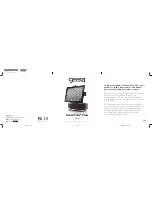
a visual difference between
the two conductors of each
molded pair of speaker wire.
Differentiating marks can be a
different color wire (copper or
“silver”); a strand of yarn in one
conductor; thin, raised ribs on one
part of the outer insulation; or a
printed “+” marking on one of the
insulators. It does not make any
difference which of the two strands
of wire go to (+) and (–) on the
speakers and amplifier, as long as
all speakers used in your system
are connected identically. Push
down on the button below the
terminal and insert the wire, or the
banana plug, through the hole.
For each channel, the red terminal
on all loudspeakers should be
connected to the red or (+)
speaker connection terminal on
the receiver or amplifier, and the
black to the black or (–) (see Fig. 2).
Connecting the loudspeakers in
this manner ensures that they will
be in phase; that is, work together
rather than in opposition.
Connecting the loudspeakers out
of phase will not damage them,
but will result in less bass and
poor imaging.
4
CONNECTIONS
To connect the loudspeaker
systems to the receiver or
amplifier, use two-conductor
insulated wire. Your JBL dealer
can recommend suitable cables,
or you can buy wire at most
hardware or electronic stores.
High quality connectors and cable
offer consistent performance that
does not deteriorate over time. We
recommend #16 AWG wire as a
minimum size. If your speaker
is more than 30 feet (10 m) from
your receiver or amplifier, use
larger diameter lower gauge wire.
Connections are made at the
terminals located on the back of
the loudspeaker system. The
terminals accept bare wire or dual
banana plugs, either of which will
provide easy, secure connections.
Preparing The Hookup Wire
Carefully plan your wire lengths
before cutting any speaker wire.
Be sure to allow plenty of extra
wire to help hide paths in corners,
along baseboards, etc.
1. First determine the distance
between the most distant speaker
and the receiver or amplifier.
2. Now make the hookup wires for
both speakers this length, even if
one LXE Series loudspeaker is
much closer to your amplifier than
the other. This will help maintain
proper signal balance.
3. Strip off 3/8" of insulation from
both ends of each conductor.
4. Twist each set of thin wires into
a tightly-bunched spiral.
5. At this point you need to identify
Left
Speaker
Amplifier/Receiver
Right
Speaker
Red Blk.
(+)
+
+
(–)
Red
R
L
Blk.
(+) (–)
Fig. 2
LXE owners manual 7/27/98 4:34 PM Page 3

























